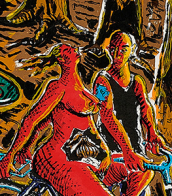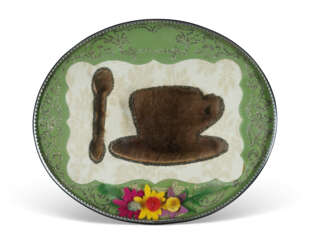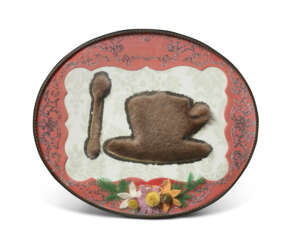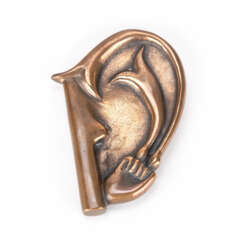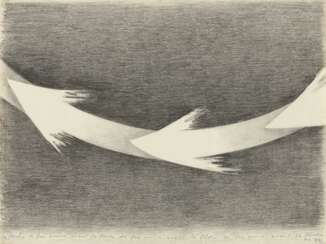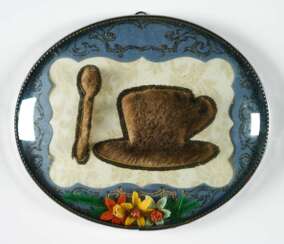мерет оппенгейм (1913 - 1985)
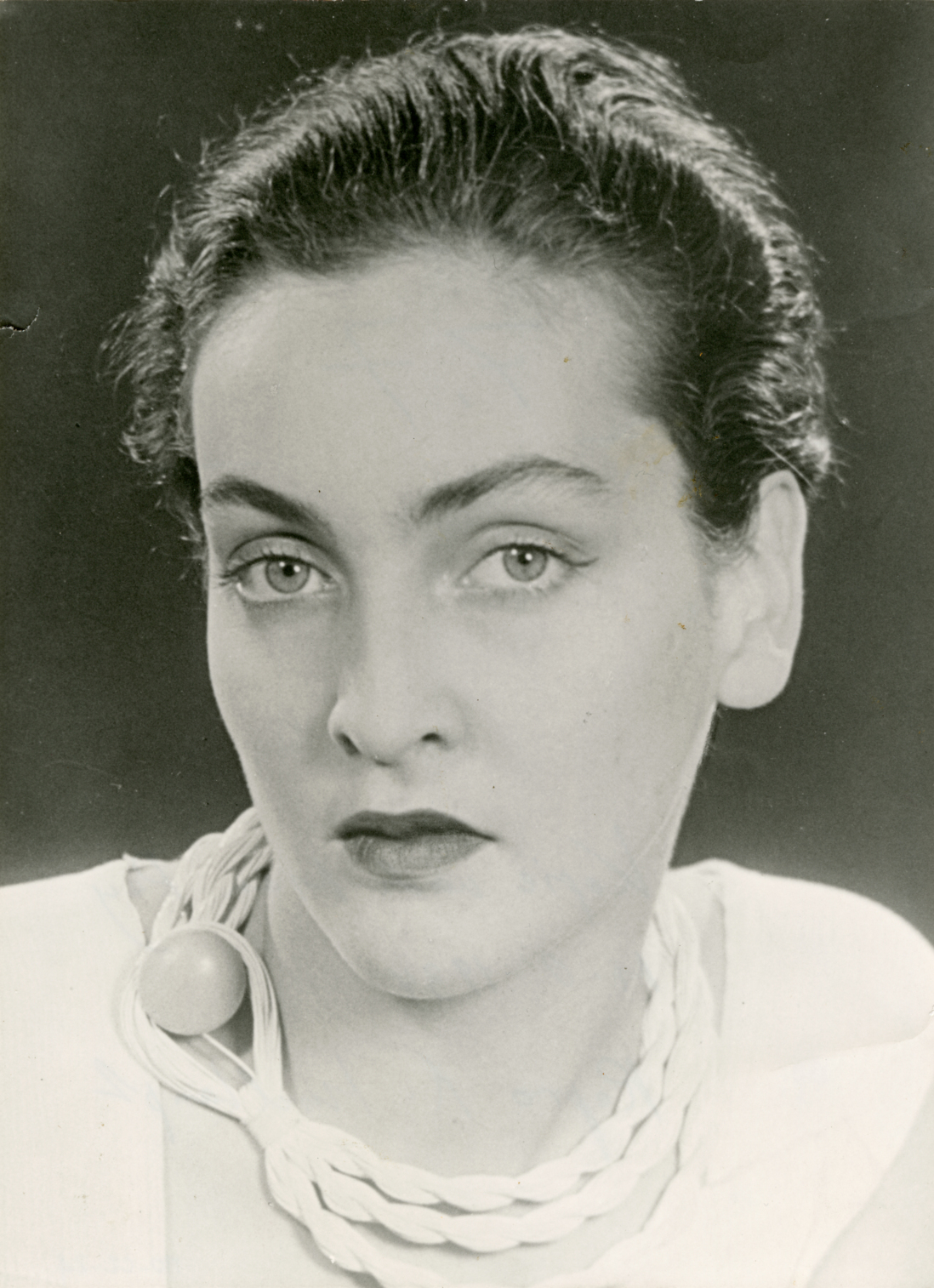
Meret Oppenheim was a Swiss artist. She is best known for her surrealist sculptures and objects, which often featured everyday objects that had been transformed through unexpected combinations and juxtapositions.
Oppenheim was part of the surrealist movement, which aimed to liberate the unconscious mind and challenge traditional ideas about art and reality. Her most famous work is "Object" (1936), a fur-covered teacup, saucer, and spoon that has become an iconic symbol of surrealist art.
Oppenheim's work often explored themes of gender and sexuality, and she was interested in the idea of transforming everyday objects into works of art. She frequently used materials such as fur, leather, and feathers in her work, which added a tactile element to her sculptures.
Oppenheim was also an accomplished painter and photographer, and her work often incorporated elements of these mediums as well. She was a trailblazer for women in the art world and was one of the few female artists to achieve recognition during the male-dominated surrealist movement.
Today, Oppenheim's work is celebrated for its wit, humor, and subversive power, and she is considered one of the most important artists of the 20th century.


Meret Oppenheim was a Swiss artist. She is best known for her surrealist sculptures and objects, which often featured everyday objects that had been transformed through unexpected combinations and juxtapositions.
Oppenheim was part of the surrealist movement, which aimed to liberate the unconscious mind and challenge traditional ideas about art and reality. Her most famous work is "Object" (1936), a fur-covered teacup, saucer, and spoon that has become an iconic symbol of surrealist art.
Oppenheim's work often explored themes of gender and sexuality, and she was interested in the idea of transforming everyday objects into works of art. She frequently used materials such as fur, leather, and feathers in her work, which added a tactile element to her sculptures.
Oppenheim was also an accomplished painter and photographer, and her work often incorporated elements of these mediums as well. She was a trailblazer for women in the art world and was one of the few female artists to achieve recognition during the male-dominated surrealist movement.
Today, Oppenheim's work is celebrated for its wit, humor, and subversive power, and she is considered one of the most important artists of the 20th century.
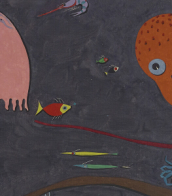

Meret Oppenheim was a Swiss artist. She is best known for her surrealist sculptures and objects, which often featured everyday objects that had been transformed through unexpected combinations and juxtapositions.
Oppenheim was part of the surrealist movement, which aimed to liberate the unconscious mind and challenge traditional ideas about art and reality. Her most famous work is "Object" (1936), a fur-covered teacup, saucer, and spoon that has become an iconic symbol of surrealist art.
Oppenheim's work often explored themes of gender and sexuality, and she was interested in the idea of transforming everyday objects into works of art. She frequently used materials such as fur, leather, and feathers in her work, which added a tactile element to her sculptures.
Oppenheim was also an accomplished painter and photographer, and her work often incorporated elements of these mediums as well. She was a trailblazer for women in the art world and was one of the few female artists to achieve recognition during the male-dominated surrealist movement.
Today, Oppenheim's work is celebrated for its wit, humor, and subversive power, and she is considered one of the most important artists of the 20th century.


Meret Oppenheim was a Swiss artist. She is best known for her surrealist sculptures and objects, which often featured everyday objects that had been transformed through unexpected combinations and juxtapositions.
Oppenheim was part of the surrealist movement, which aimed to liberate the unconscious mind and challenge traditional ideas about art and reality. Her most famous work is "Object" (1936), a fur-covered teacup, saucer, and spoon that has become an iconic symbol of surrealist art.
Oppenheim's work often explored themes of gender and sexuality, and she was interested in the idea of transforming everyday objects into works of art. She frequently used materials such as fur, leather, and feathers in her work, which added a tactile element to her sculptures.
Oppenheim was also an accomplished painter and photographer, and her work often incorporated elements of these mediums as well. She was a trailblazer for women in the art world and was one of the few female artists to achieve recognition during the male-dominated surrealist movement.
Today, Oppenheim's work is celebrated for its wit, humor, and subversive power, and she is considered one of the most important artists of the 20th century.


Meret Oppenheim was a Swiss artist. She is best known for her surrealist sculptures and objects, which often featured everyday objects that had been transformed through unexpected combinations and juxtapositions.
Oppenheim was part of the surrealist movement, which aimed to liberate the unconscious mind and challenge traditional ideas about art and reality. Her most famous work is "Object" (1936), a fur-covered teacup, saucer, and spoon that has become an iconic symbol of surrealist art.
Oppenheim's work often explored themes of gender and sexuality, and she was interested in the idea of transforming everyday objects into works of art. She frequently used materials such as fur, leather, and feathers in her work, which added a tactile element to her sculptures.
Oppenheim was also an accomplished painter and photographer, and her work often incorporated elements of these mediums as well. She was a trailblazer for women in the art world and was one of the few female artists to achieve recognition during the male-dominated surrealist movement.
Today, Oppenheim's work is celebrated for its wit, humor, and subversive power, and she is considered one of the most important artists of the 20th century.


Meret Oppenheim was a Swiss artist. She is best known for her surrealist sculptures and objects, which often featured everyday objects that had been transformed through unexpected combinations and juxtapositions.
Oppenheim was part of the surrealist movement, which aimed to liberate the unconscious mind and challenge traditional ideas about art and reality. Her most famous work is "Object" (1936), a fur-covered teacup, saucer, and spoon that has become an iconic symbol of surrealist art.
Oppenheim's work often explored themes of gender and sexuality, and she was interested in the idea of transforming everyday objects into works of art. She frequently used materials such as fur, leather, and feathers in her work, which added a tactile element to her sculptures.
Oppenheim was also an accomplished painter and photographer, and her work often incorporated elements of these mediums as well. She was a trailblazer for women in the art world and was one of the few female artists to achieve recognition during the male-dominated surrealist movement.
Today, Oppenheim's work is celebrated for its wit, humor, and subversive power, and she is considered one of the most important artists of the 20th century.


Meret Oppenheim was a Swiss artist. She is best known for her surrealist sculptures and objects, which often featured everyday objects that had been transformed through unexpected combinations and juxtapositions.
Oppenheim was part of the surrealist movement, which aimed to liberate the unconscious mind and challenge traditional ideas about art and reality. Her most famous work is "Object" (1936), a fur-covered teacup, saucer, and spoon that has become an iconic symbol of surrealist art.
Oppenheim's work often explored themes of gender and sexuality, and she was interested in the idea of transforming everyday objects into works of art. She frequently used materials such as fur, leather, and feathers in her work, which added a tactile element to her sculptures.
Oppenheim was also an accomplished painter and photographer, and her work often incorporated elements of these mediums as well. She was a trailblazer for women in the art world and was one of the few female artists to achieve recognition during the male-dominated surrealist movement.
Today, Oppenheim's work is celebrated for its wit, humor, and subversive power, and she is considered one of the most important artists of the 20th century.


Meret Oppenheim was a Swiss artist. She is best known for her surrealist sculptures and objects, which often featured everyday objects that had been transformed through unexpected combinations and juxtapositions.
Oppenheim was part of the surrealist movement, which aimed to liberate the unconscious mind and challenge traditional ideas about art and reality. Her most famous work is "Object" (1936), a fur-covered teacup, saucer, and spoon that has become an iconic symbol of surrealist art.
Oppenheim's work often explored themes of gender and sexuality, and she was interested in the idea of transforming everyday objects into works of art. She frequently used materials such as fur, leather, and feathers in her work, which added a tactile element to her sculptures.
Oppenheim was also an accomplished painter and photographer, and her work often incorporated elements of these mediums as well. She was a trailblazer for women in the art world and was one of the few female artists to achieve recognition during the male-dominated surrealist movement.
Today, Oppenheim's work is celebrated for its wit, humor, and subversive power, and she is considered one of the most important artists of the 20th century.


Meret Oppenheim was a Swiss artist. She is best known for her surrealist sculptures and objects, which often featured everyday objects that had been transformed through unexpected combinations and juxtapositions.
Oppenheim was part of the surrealist movement, which aimed to liberate the unconscious mind and challenge traditional ideas about art and reality. Her most famous work is "Object" (1936), a fur-covered teacup, saucer, and spoon that has become an iconic symbol of surrealist art.
Oppenheim's work often explored themes of gender and sexuality, and she was interested in the idea of transforming everyday objects into works of art. She frequently used materials such as fur, leather, and feathers in her work, which added a tactile element to her sculptures.
Oppenheim was also an accomplished painter and photographer, and her work often incorporated elements of these mediums as well. She was a trailblazer for women in the art world and was one of the few female artists to achieve recognition during the male-dominated surrealist movement.
Today, Oppenheim's work is celebrated for its wit, humor, and subversive power, and she is considered one of the most important artists of the 20th century.


Meret Oppenheim was a Swiss artist. She is best known for her surrealist sculptures and objects, which often featured everyday objects that had been transformed through unexpected combinations and juxtapositions.
Oppenheim was part of the surrealist movement, which aimed to liberate the unconscious mind and challenge traditional ideas about art and reality. Her most famous work is "Object" (1936), a fur-covered teacup, saucer, and spoon that has become an iconic symbol of surrealist art.
Oppenheim's work often explored themes of gender and sexuality, and she was interested in the idea of transforming everyday objects into works of art. She frequently used materials such as fur, leather, and feathers in her work, which added a tactile element to her sculptures.
Oppenheim was also an accomplished painter and photographer, and her work often incorporated elements of these mediums as well. She was a trailblazer for women in the art world and was one of the few female artists to achieve recognition during the male-dominated surrealist movement.
Today, Oppenheim's work is celebrated for its wit, humor, and subversive power, and she is considered one of the most important artists of the 20th century.


Meret Oppenheim was a Swiss artist. She is best known for her surrealist sculptures and objects, which often featured everyday objects that had been transformed through unexpected combinations and juxtapositions.
Oppenheim was part of the surrealist movement, which aimed to liberate the unconscious mind and challenge traditional ideas about art and reality. Her most famous work is "Object" (1936), a fur-covered teacup, saucer, and spoon that has become an iconic symbol of surrealist art.
Oppenheim's work often explored themes of gender and sexuality, and she was interested in the idea of transforming everyday objects into works of art. She frequently used materials such as fur, leather, and feathers in her work, which added a tactile element to her sculptures.
Oppenheim was also an accomplished painter and photographer, and her work often incorporated elements of these mediums as well. She was a trailblazer for women in the art world and was one of the few female artists to achieve recognition during the male-dominated surrealist movement.
Today, Oppenheim's work is celebrated for its wit, humor, and subversive power, and she is considered one of the most important artists of the 20th century.


Meret Oppenheim was a Swiss artist. She is best known for her surrealist sculptures and objects, which often featured everyday objects that had been transformed through unexpected combinations and juxtapositions.
Oppenheim was part of the surrealist movement, which aimed to liberate the unconscious mind and challenge traditional ideas about art and reality. Her most famous work is "Object" (1936), a fur-covered teacup, saucer, and spoon that has become an iconic symbol of surrealist art.
Oppenheim's work often explored themes of gender and sexuality, and she was interested in the idea of transforming everyday objects into works of art. She frequently used materials such as fur, leather, and feathers in her work, which added a tactile element to her sculptures.
Oppenheim was also an accomplished painter and photographer, and her work often incorporated elements of these mediums as well. She was a trailblazer for women in the art world and was one of the few female artists to achieve recognition during the male-dominated surrealist movement.
Today, Oppenheim's work is celebrated for its wit, humor, and subversive power, and she is considered one of the most important artists of the 20th century.


Meret Oppenheim was a Swiss artist. She is best known for her surrealist sculptures and objects, which often featured everyday objects that had been transformed through unexpected combinations and juxtapositions.
Oppenheim was part of the surrealist movement, which aimed to liberate the unconscious mind and challenge traditional ideas about art and reality. Her most famous work is "Object" (1936), a fur-covered teacup, saucer, and spoon that has become an iconic symbol of surrealist art.
Oppenheim's work often explored themes of gender and sexuality, and she was interested in the idea of transforming everyday objects into works of art. She frequently used materials such as fur, leather, and feathers in her work, which added a tactile element to her sculptures.
Oppenheim was also an accomplished painter and photographer, and her work often incorporated elements of these mediums as well. She was a trailblazer for women in the art world and was one of the few female artists to achieve recognition during the male-dominated surrealist movement.
Today, Oppenheim's work is celebrated for its wit, humor, and subversive power, and she is considered one of the most important artists of the 20th century.


Meret Oppenheim was a Swiss artist. She is best known for her surrealist sculptures and objects, which often featured everyday objects that had been transformed through unexpected combinations and juxtapositions.
Oppenheim was part of the surrealist movement, which aimed to liberate the unconscious mind and challenge traditional ideas about art and reality. Her most famous work is "Object" (1936), a fur-covered teacup, saucer, and spoon that has become an iconic symbol of surrealist art.
Oppenheim's work often explored themes of gender and sexuality, and she was interested in the idea of transforming everyday objects into works of art. She frequently used materials such as fur, leather, and feathers in her work, which added a tactile element to her sculptures.
Oppenheim was also an accomplished painter and photographer, and her work often incorporated elements of these mediums as well. She was a trailblazer for women in the art world and was one of the few female artists to achieve recognition during the male-dominated surrealist movement.
Today, Oppenheim's work is celebrated for its wit, humor, and subversive power, and she is considered one of the most important artists of the 20th century.
